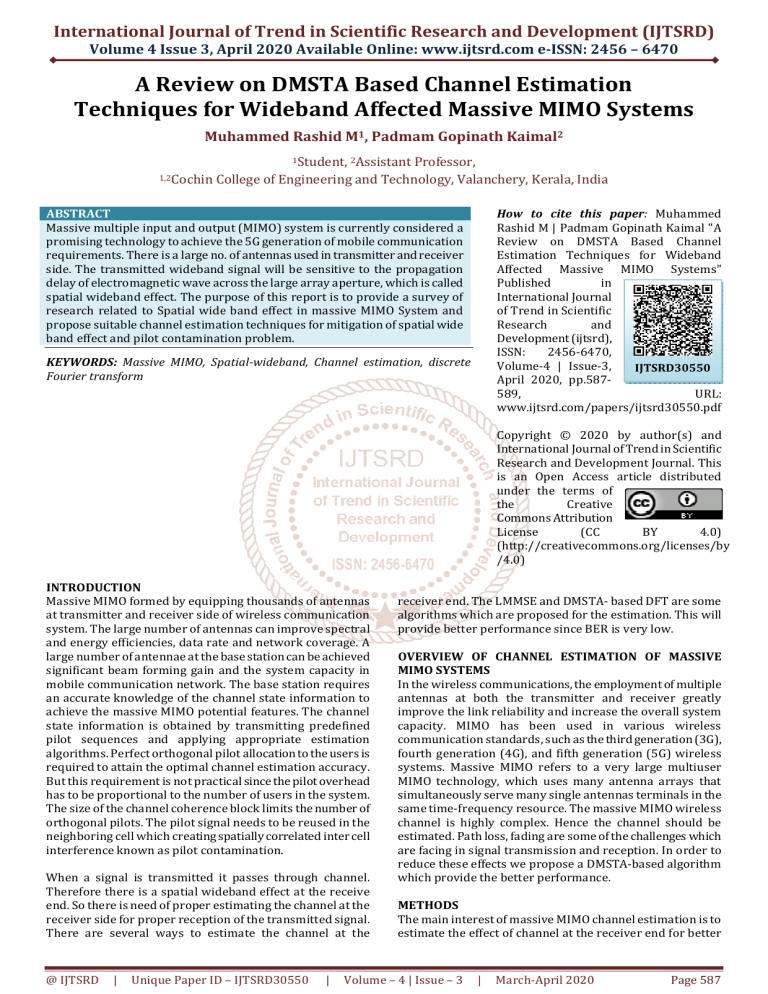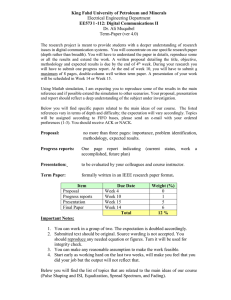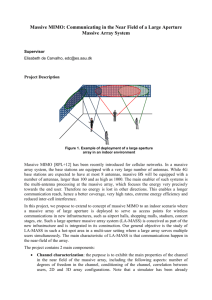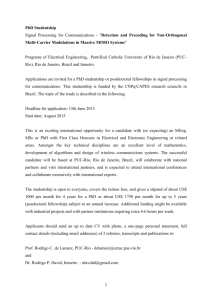
International Journal of Trend in Scientific Research and Development (IJTSRD)
Volume 4 Issue 3, April 2020 Available Online: www.ijtsrd.com e-ISSN: 2456 – 6470
A Review on DMSTA Based Channel Estimation
Techniques for Wideband Affected Massive MIMO Systems
Muhammed Rashid M1, Padmam Gopinath Kaimal2
1Student, 2Assistant
1,2Cochin
Professor,
College of Engineering and Technology, Valanchery, Kerala, India
How to cite this paper: Muhammed
Rashid M | Padmam Gopinath Kaimal "A
Review on DMSTA Based Channel
Estimation Techniques for Wideband
Affected Massive MIMO Systems"
Published
in
International Journal
of Trend in Scientific
Research
and
Development (ijtsrd),
ISSN:
2456-6470,
Volume-4 | Issue-3,
IJTSRD30550
April 2020, pp.587589,
URL:
www.ijtsrd.com/papers/ijtsrd30550.pdf
ABSTRACT
Massive multiple input and output (MIMO) system is currently considered a
promising technology to achieve the 5G generation of mobile communication
requirements. There is a large no. of antennas used in transmitter and receiver
side. The transmitted wideband signal will be sensitive to the propagation
delay of electromagnetic wave across the large array aperture, which is called
spatial wideband effect. The purpose of this report is to provide a survey of
research related to Spatial wide band effect in massive MIMO System and
propose suitable channel estimation techniques for mitigation of spatial wide
band effect and pilot contamination problem.
KEYWORDS: Massive MIMO, Spatial-wideband, Channel estimation, discrete
Fourier transform
Copyright © 2020 by author(s) and
International Journal of Trend in Scientific
Research and Development Journal. This
is an Open Access article distributed
under the terms of
the
Creative
Commons Attribution
License
(CC
BY
4.0)
(http://creativecommons.org/licenses/by
/4.0)
INTRODUCTION
Massive MIMO formed by equipping thousands of antennas
at transmitter and receiver side of wireless communication
system. The large number of antennas can improve spectral
and energy efficiencies, data rate and network coverage. A
large number of antennae at the base station can be achieved
significant beam forming gain and the system capacity in
mobile communication network. The base station requires
an accurate knowledge of the channel state information to
achieve the massive MIMO potential features. The channel
state information is obtained by transmitting predefined
pilot sequences and applying appropriate estimation
algorithms. Perfect orthogonal pilot allocation to the users is
required to attain the optimal channel estimation accuracy.
But this requirement is not practical since the pilot overhead
has to be proportional to the number of users in the system.
The size of the channel coherence block limits the number of
orthogonal pilots. The pilot signal needs to be reused in the
neighboring cell which creating spatially correlated inter cell
interference known as pilot contamination.
When a signal is transmitted it passes through channel.
Therefore there is a spatial wideband effect at the receive
end. So there is need of proper estimating the channel at the
receiver side for proper reception of the transmitted signal.
There are several ways to estimate the channel at the
@ IJTSRD
|
Unique Paper ID – IJTSRD30550
|
receiver end. The LMMSE and DMSTA- based DFT are some
algorithms which are proposed for the estimation. This will
provide better performance since BER is very low.
OVERVIEW OF CHANNEL ESTIMATION OF MASSIVE
MIMO SYSTEMS
In the wireless communications, the employment of multiple
antennas at both the transmitter and receiver greatly
improve the link reliability and increase the overall system
capacity. MIMO has been used in various wireless
communication standards, such as the third generation (3G),
fourth generation (4G), and fifth generation (5G) wireless
systems. Massive MIMO refers to a very large multiuser
MIMO technology, which uses many antenna arrays that
simultaneously serve many single antennas terminals in the
same time-frequency resource. The massive MIMO wireless
channel is highly complex. Hence the channel should be
estimated. Path loss, fading are some of the challenges which
are facing in signal transmission and reception. In order to
reduce these effects we propose a DMSTA-based algorithm
which provide the better performance.
METHODS
The main interest of massive MIMO channel estimation is to
estimate the effect of channel at the receiver end for better
Volume – 4 | Issue – 3
|
March-April 2020
Page 587
International Journal of Trend in Scientific Research and Development (IJTSRD) @ www.ijtsrd.com eISSN: 2456-6470
reception of the signal. In terms of research objectives,
previous area can be divided into three categories. The first
category which estimate channel based on the directly
extended from the conventional MIMO channel model,
second category which estimate channel with considering
the spatial wideband effect but not considering pilot
contamination problem and the third category which
estimate channel with considering both spatial wideband
effect and pilot contamination problem.
A. Detection Based on Directly extended from the
conventional MIMO.
Signal detection implies accurate estimation of the transmit
vector knowing the received vector and the channel. Channel
estimation of massive MIMO can be done using linear or
nonlinear algorithms. Linear detection generally generates
soft estimates of the transmitted vectors [7]. Linear
detection has less complexity but it has lower performance
and limited spectral efficiency. The performance of linear
detectors deteriorates rapidly as the number of transmitting
antennas increases. Lattice Reduction (LR) of massive MIMO
is based on linear detection . It has better performance than
ordinary linear detection. However, instead of applying the
linear transformation to the massive MIMO received signal
model, they apply it to an equivalent system model obtained
using LR-techniques. The new channel matrix is more
orthogonal than the old one. Slicing is done on the received
data vector instead of the transmitted vector.
B. Detection with considering spatial wide band Effect
only.
The performance of massive MIMO systems depends on the
favorable propagation delay condition equivalent to the
asymptotic orthogonality of channel impulse vectors
associated with different users in cells. In work [1] channel is
usually modeled as the ideal Gaussian channel matrix with
elements following the mutually independent Gaussian
distribution, so that channel vectors associated with
different users are asymptotically orthogonal and can
provide the favorable propagation condition for massive
MIMO system. The massive MIMO communications by
considering the dual-wideband effects from the array signal
processing [8] viewpoint. A massive MIMO channel with the
spatial-wideband effects is modeled as a function of limited
parameters such as the complex gain, the direction of arrival
or the direction of departure , and the time delay of each
channel path by exploiting the channel sparsity in both angle
and delay domains. In massive MIMO systems, especially
over mmWave-band, the narrowband assumption does not
valid any more. In this case, the conventional massive MIMO
channel model [6] and other models that directly extended
from the conventional models will be inapplicable. The
algorithms without considering the spatial-wideband effect
will suffer from the performance loss when either the
number of base antennas or the transmission bandwidth
becomes large.
C. Detection with considering spatial wide band Effect
and Pilot contamination problem.
In work [3] channel estimate with considering both spatial
wideband effect and pilot contamination problem. When a
signal propagates from the transmitter to the receiver, it
experiences the effect of spatial effect, scattering, fading, and
path loss in the channel. Knowing the channel impulse in
both forward and reverse links is crucial for accomplishing
@ IJTSRD
|
Unique Paper ID – IJTSRD30550
|
successful transmission under various channel conditions.
Training sequences are designed to optimize an equalizer at
the receiver by providing channel impulse. In massive MIMO
systems, the pilot signal is used to estimate the channel
impulse in both directions. For downlink transmission, the
pilot signal sample period should be longer than the number
of transmitting base antennas. For uplink transmission, the
pilot signal sample period should be longer than the number
of users (K), so that the BS would learn the uplink channel
matrix. Pilot contamination is a major problem in massive
MIMO, which is caused by non-orthogonality of pilot signal
used in adjacent cells. Usually, reusing pilots in multiple cells
is the main cause of the problem. In this case, the estimated
channel impulse vector in any cell is the summation of all the
channel impulse vectors of users from the neighboring cells.
As the number of interfering cells increase, the problem
exponentially grows and eventually causes system
malfunction.
CONCLUSION
We have presented a various channel estimation methods
used in a massive MIMO system. The advantages and
limitations of various estimation methods are described.
However, channel estimation with considering spatial
wideband effect and pilot contamination problem provides
better performance. it allows for low BER and SNR. It can
capture the sparseness of the system to provide better
performance.
REFERENCES
[1] Bolei Wang, Feifei Gao, Shi Jin, and Hai Lin and Geoffrey
Ye Li (2018), “Spatial and Frequency Wideband Effect
in massive MIMO Systems,” IEEE Trans.sinal
Processing and Control, vol. 39, pp. 230–236.
[2] Y. Han, J. Lee, and D. J. Love (2017), “Compressed
sensing-aided downlink channel training for FDD
massive MIMO systems,” IEEE Trans. Commun., vol. 65,
no. 7, pp. 2852–2862.
[3] J. C. Chen (2017), “Hybrid beam forming with discrete
phase shifters for millimeter-wave massive MIMO
systems,” IEEE Trans. Veh. Technol., vol. 66, no. 8, pp.
7604.
[4] F. Sohrabi and W. Yu (2016), “Hybrid digital and analog
beamforming design for large-scale antenna arrays,”
IEEE J. Sel. Top. Signal Process., vol. 10, no. 3, pp. 501–
513.
[5]
R. W. Heath, N. Gonzalez-Prelcic, S. Rangan, W. Roh,
and A. M. Sayeed (2016), “An overview of signal
processing techniques for millimeter wave MIMO
systems,” IEEE J. Sel. Top. Signal Process., vol. 10, no. 3,
pp. 436–453
[6] O. E. Ayach, S. Rajagopal, S. Abu-Surra, Z. Pi, and R. W.
Heath, “Spatially sparse precoding in millimeter wave
MIMO systems,” IEEE Trans. Wirel. Commun., vol.13,
no. 3, pp. 1499–1513, Mar. 2014.
[7] J. J. G. Andrews, S. Buzzi, W. Choi, S. V. S. Hanly, A.
Lozano(2014), “What will 5G be,” IEEE
Trans.Communication System.
[8] Chockalingam, A.; Rajan, B.S. Large MIMO Systems;
Cambridge University Press: Cambridge, UK, 2014
Volume – 4 | Issue – 3
|
March-April 2020
Page 588
International Journal of Trend in Scientific Research and Development (IJTSRD) @ www.ijtsrd.com eISSN: 2456-6470
[9] W. Roh, J. Y. Seol, J. H. Park, B. Lee, J. Lee, Y. Kim, J. Cho,
K. (2014),“Millimeter–wave beamformforming as an
enabling technology for 5G Cellular communication ,”
IEEE Commun.mang.vol,52.
[11] T. L. Marzetta (2010), “Noncooperative cellular
wireless with unlimited numbers of base station
antennas,” IEEE Trans. Wirel. Commun., vol. 9, no.11,
pp. 35-360.
[10] H. Yin, D. Gesbert, M. Filippou, and Y. Liu (2013), “A
coordinated approach to channel estimation in largescale multiple-antenna systems,” IEEE J. Sel. Areas
Commun., vol. 31, no. 2, pp. 264–273.
[12] H. Xie, F. Gao, and S. Jin (2006), “An overview of lowrank channel estimation for massive MIMO systems,”
IEEE Access, vol. 4, pp. 7313.
@ IJTSRD
|
Unique Paper ID – IJTSRD30550
|
Volume – 4 | Issue – 3
|
March-April 2020
Page 589





